Growing zinnias is easy and SO rewarding! Not only are they gorgeous and colorful, they also attract pollinators.
In this post, you’l learn everything there is to know about zinnia plant care, including tips for water, sun, soil, fertilizer, pruning, and much more!
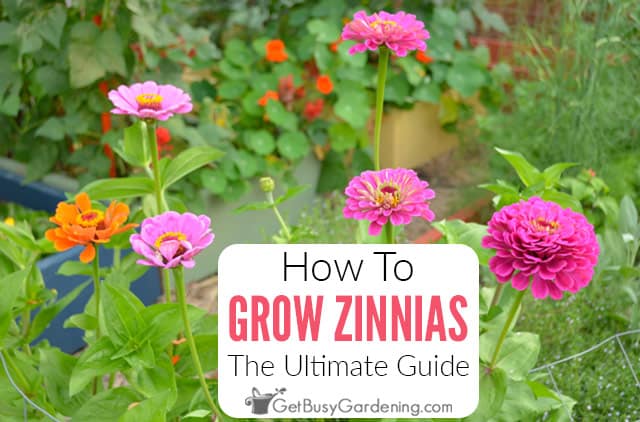
I grow zinnias in my garden every year, and absolutely love them! Every time I look out my window, they are one of the first things that catch my eye.
In my opinion, these beautiful and resilient flowers are a must for every garden! If you’ve never grown zinnias before, you should definitely add them to your list.
They are an old fashioned garden staple, and their popularity is understandable. These days, you can find them in all shapes, sizes, and colors.
In this detailed zinnia care guide, you will learn everything you need to grow these incredible blossoms in your garden every summer.
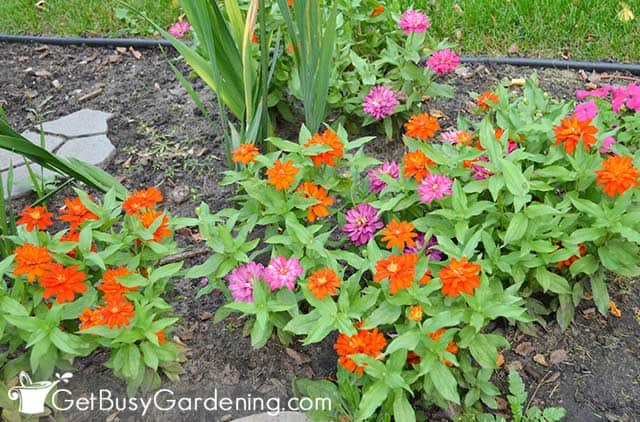
Information About Zinnias
Zinnia, which is both the Latin and common name for this plant, is native to Mexico. You probably won’t be surprised to learn that they belong to the daisy family of flowers.
These fast-growing plants range in height from 6 to 36 inches. The midsummer explosion of colorful, abundant blooms continues up to the first hard frost in the fall.
Not only are the blooms gorgeous, they also attract hummingbirds, bees, and butterflies, which really adds to their overall appeal.
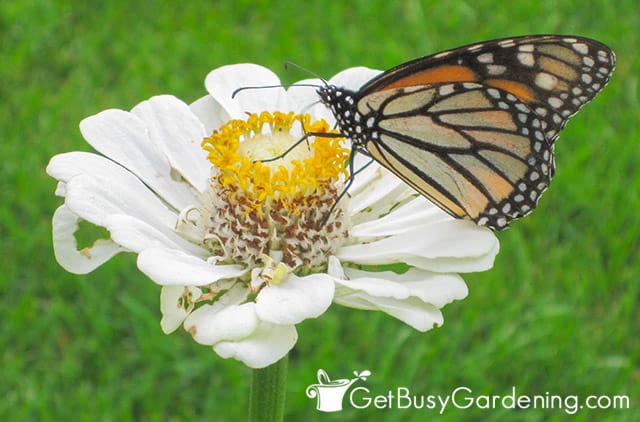
Hardiness
Zinnias are a true annual plant, which means they complete their life cycle within one growing season. They are not perennials in any location.
This plant loves hot weather, and will not tolerate the cold at all. Once these beauties come in contact with freezing temperatures, they will die.
In warmer climates, zinnias can reseed themselves as annual wildflowers. But the rest of us must replant them every year.
Fortunately, they mature quickly, so you can enjoy them for several months no matter where you live.
Flowers
Once they reach maturity, zinnias will bloom continuously until frost kills them, or they come to the end of their natural lifecycle.
The best part is that the blooms come in a rainbow of colors. They also make fantastic cut flowers that will last for several days in a vase or arrangement.
You may also notice that the shape of the flowers can be different, depending on the variety you choose. Basically, there are three different petal arrangements to look for…
- Single flowered – These flowers have a visible center surrounded by a single row of petals, and are best for attracting pollinators.
- Double flowered – Since there are multiple rows of petals, the center is not as visible. These flowers are more rounded, and fuller than the others.
- Semi double – This one falls somewhere in between the other two. These blossoms have a visible center, as well as multiple rows of petals. They’re great for pollinators as well.
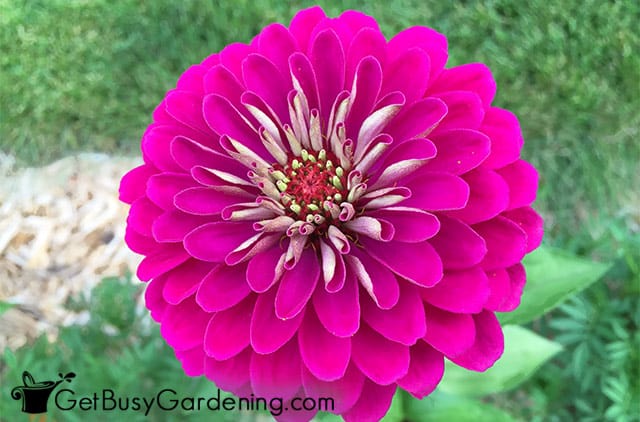
Different Types Of Zinnias To Grow
The best part about growing zinnias is that they come in several beautiful varieties, and a wide range of colors.
There are too many types to create an exhaustive list. So here I will list some of the more exciting and noteworthy ones you might want to try…
- Giants Mix – If you’re looking for a variety that produces huge blooms and attractive cut flowers, this one is a good choice.
- Double Zahara – This variety features large flowers, and the plant is resistant to powdery mildew.
- Profusion Series – A hybrid that is a cross between Zinnia elegans and Zinnia angustifolia, this one makes a robust border plant.
- Dreamland Series – This variety is dwarf and compact, with large and showy 4-inch blooms, and less issues with disease.
- Thumbelina – An old-fashioned dwarf variety that produces an abundance of flowers on short 12-inch stems. Perfect for pots, or lining the outer edges of any flower bed.
- State Fair Series – These beautiful 5-inch blooms are show stoppers, and the plant is disease resistant as well.

Benefits Of Growing Zinnias
In case you haven’t guessed it yet, zinnias are one of my favorite flowers to grow in my garden. But, if you’re not convinced yet, here’s a list of all the wonderful benefits they have to offer…
- Fast growers – Since they mature very quickly, anyone can grow them, no matter where you live.
- Add tons of color – Their bright, eye-popping blooms are a real attention getter, and they come in pretty much any color you can think of!
- Grow reliably – They are very tough, and require minimal care. Definitely one of the easiest, no-fuss plants in my garden.
- Low maintenance – You can just plant ’em and forget ’em. They even do great in dry garden beds.
- Excellent cut flowers – I add them to almost every arrangement I create during the summer, and they outlast most other flowers I cut.
- Attract pollinators – Beneficial pollinators like bees, butterflies, and hummingbirds absolutely love them. Heck, you might want to grow zinnias for this reason alone!
- Versatile – They do equally well in pots as they do in the ground, so you can plant them just about anywhere. They are ideal for the first time gardener.
- Constant blooms – Easily one of the first to flower in my annual gardens, and they bloom prolifically through first frost.
How To Grow Zinnias
To successfully grow zinnias, it’s important to know where and when to plant them. So before I get into the detailed care instructions, here are some quick planting tips…
Where To Grow Zinnias
Since they are so simple to grow, some people use zinnias to fill vacant spots throughout their garden, or devote entire beds to them.
Dwarf varieties also do very well in pots and containers, and are wonderful for adding pops of color to a sunny deck, balcony, or patio.
These resilient plants will perform well in challenging conditions. But for best results, select a full sun site that has fast-draining soil.
When To Plant Zinnias
Since they are not cold hardy, wait to plant zinnias until after all chance of frost is gone, and the soil has warmed in early summer.
It is not beneficial to plant them early, because the cold will stunt their growth, and a late spring frost could kill them.
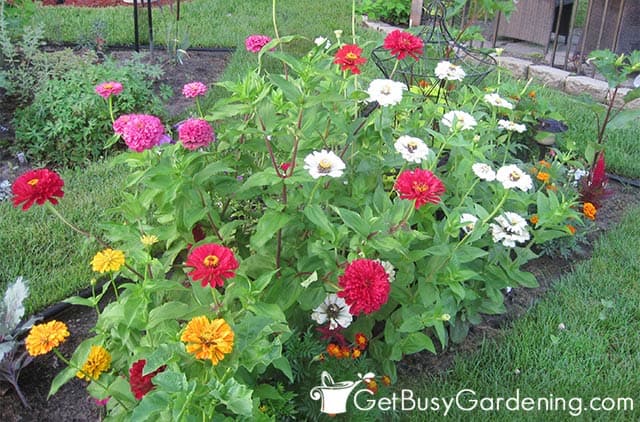
Zinnia Care & Growing Instructions
The great news is that zinnia plant care is extremely easy. These tough plants are heat and drought-tolerant, and will endure cooler temperatures later in the fall as well.
Water
Though they can tolerate dry conditions, zinnias still need regular watering to support healthy growth. Insufficient water will result in smaller plants with fewer blooms.
So, plan to water them once or twice per week during dry spells, but do not saturate the soil. They don’t like having wet feet, and overwatering will quickly kill them.
Overwatering isn’t usually an issue in the garden, but can be a problem in pots and containers. Always check the soil before you water.
It’s best to allow it to dry between waterings, and then give the plant a nice, deep drink. If you struggle to get it right, I recommend buying an inexpensive soil moisture meter to make it super easy.
Sunlight
Zinnias flourish in hot, sunny conditions. So plant this one in the full sun if you can. They produce more blooms when they get at least 6-8 hours of direct sunshine every day.
You can grow them in part shade, as long as they get at least 4 hours of sun daily. However, keep in mind that they will not bloom as profusely if they get too much shade.
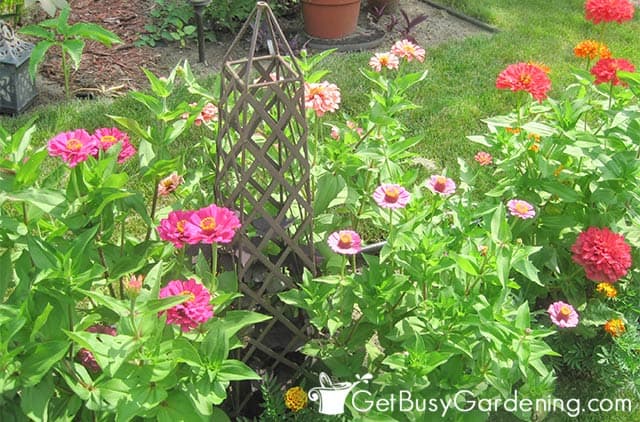
Soil
The good news is that zinnias are not too picky, and will grow in almost any type of soil. But they do prefer fertile soil that is full of organic matter, and also fast-draining.
High-quality soil that is rich in humus and organic matter will result in healthier, more robust plants and flowers. You can amend your beds with worm castings or compost to improve the quality.
Always avoid planting zinnias in areas where water pools. But, for slow-draining soil, you can add perlite or coarse sand to increase the drainage.
In containers, use a good quality outdoor potting mix, and always be sure to plant them in a pot that has adequate drainage holes.
Fertilizing
Since zinnia plants grow an incredible amount in one season, they will perform best when fed regularly with a fertilizer that is high in phosphorus.
Start by amending the soil with slow-release granules at planting time. Then top-dress them 2-3 more times during the summer.
You can also supplement monthly with a water-soluble fertilizer, or an organic compost tea, to provide them with all the nutrients they need to thrive.
Learn more about exactly how to fertilize your flower beds here.
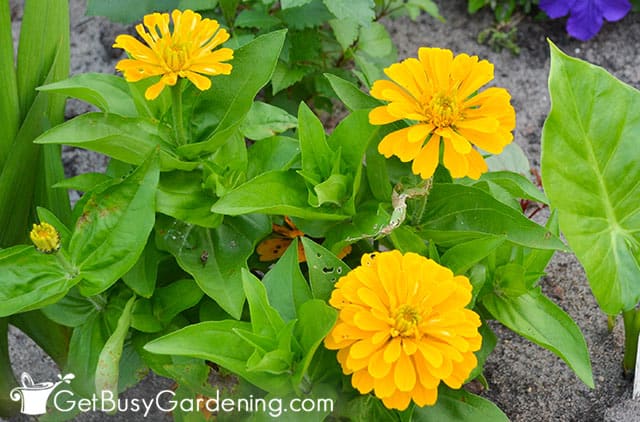
Disease Control
One of the most frustrating things about zinnia plant care is dealing with disease and mildew issues. Powdery mildew can become a problem in moist, warm, humid conditions.
Bacterial leaf spot can also attack zinnias. Symptoms include watery lesions that turn brown then black. It thrives as a result of water collecting on the leaves.
The good news is that these diseases only attack the foliage, and do not affect the blossoms. You can treat the leaves with an organic fungicide at the first sign of disease.
But, since the foliage is pretty unremarkable, and the plants are short-lived, you may just choose to tolerate it, rather than treating them.
You can also prevent disease issues by giving zinnias plenty of room for air circulation, and watering at the base of the plant to keep the leaves dry.
Pest Control
Spider mites can cause foliage damage, but it is only necessary to spray them if the loss starts to affect the overall health of the plant.
If you bring the flowers inside, carefully inspect them for signs of spider mites. This will prevent bringing these pests into your home, and infesting your interior plants.
An added benefit to growing zinnias is that they are resistant to deer and rabbits. So, if your garden is plagued by furry pests, these are a great option for you!
Pruning & Deadheading
No matter which variety you grow, all zinnias will benefit from being pruned and deadheaded regularly. Doing so will result in fuller plants, and tons of new buds.
The more you prune the flowers, the bushier the plant will grow, and the more blossoms you will get. So cutting them for vases and arrangements has a double benefit.
Deadheading also encourages new blooms. Once the flowers fade, pinch or cut them off to prevent seeds from forming, which takes energy away from the plant.
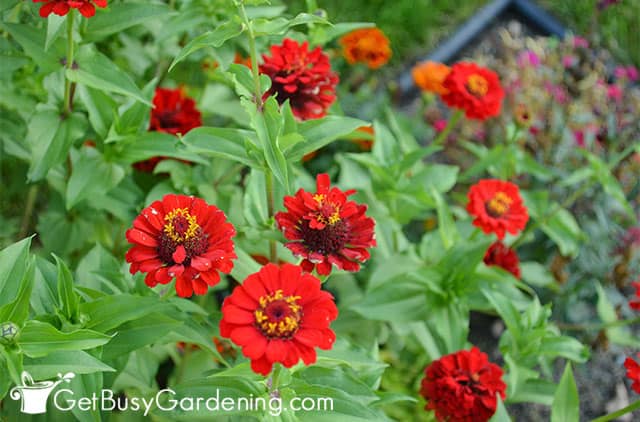
Zinnia Propagation
It’s super simple to propagate zinnias from cuttings or from seed. If you want to try rooting cuttings, then take 3-4″ long non-blooming stems, and strip off the lower leaves.
Dip the cut ends in rooting hormone, stick them in a lightweight soil medium (or a seedling mix), and place them in a humid location until you see new growth.
Or you can start the seeds indoors 6-8 weeks before last frost in spring. You can even save the seeds from you garden to grow your favorite varieties year after year.
Troubleshooting Zinnia Care Problems
Yes, it is easy to grow zinnias. But sometimes you run into trouble, and you have no idea what is wrong, or how to fix it!
So, in this section, I’m going to help you troubleshoot some of the most common zinnia care problems, and give you tips for fixing them.
Yellow Leaves
This is most likely caused by a lack of nutrients, but could also be from overwatering.
If you suspect a nutrient deficiency, start feeding them with an organic liquid fertilizer. Otherwise, make sure the soil is never wet or soggy.
Leaves Turning Brown
Could be from under watering, or sunburn on new plants. Never allow the soil to dry out completely.
If your new starts or seedlings have brown leaves, then move them to a shady spot, and slowly introduce them to full sun over the next few weeks.
Black Leaves
If there are black spots on the leaves, then it’s probably infected with bacterial leaf spot, which can be prevented by keeping the leaves dry.
Otherwise, if the leaves suddenly turned black, then it was probably caused by frost or freezing temperatures.
White Powder On Leaves
When you see white spots that look like powder on the leaves, then it’s likely powdery mildew.
Once infected, you can’t get rid of it. But you cant treat the leaves with an organic fungicide, and water at the base to slow the spread.
Zinnias Won’t Bloom
There are a few reasons why zinnias won’t flower, or don’t have many buds. It’s caused by either too much shade, improper watering, or lack of nutrients.
Make sure they are in a sunny location, that the soil drys slightly between waterings, but never bone dry, and that you feed them regularly.
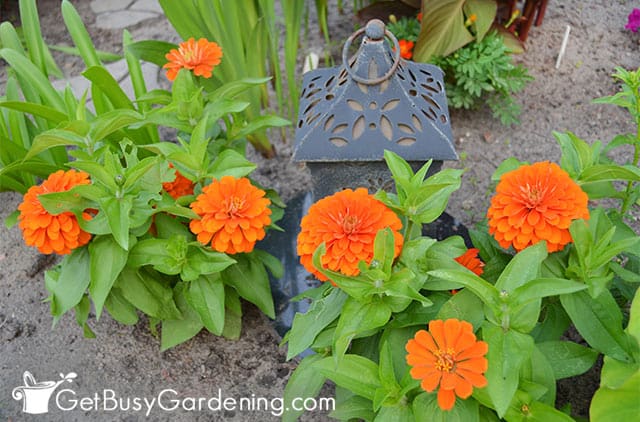
FAQs About Growing Zinnias
In this section, I will answer some of the most frequently asked questions about zinnia plant care. If you still have a question after reading through all of this, ask it in the comments below.
Do zinnias come back every year?
No, zinnias are true annual plants that will only live for one season. However, it’s not uncommon for them to reseed themselves in mild climates, making it seem like they are growing back every year.
How long do zinnia plants last?
Zinnia plants will last until either a hard freeze kills them off in the fall, or they come to the end of their natural lifespan. Since they are annual plants, their lifespan is generally about one year.
Do zinnias need full sun?
Though they do perform best in full sunlight, zinnias can survive in partial shade. They just won’t bloom as profusely when they get less sunshine.
How do I keep zinnias blooming?
The best way to keep zinnias blooming constantly is to prune or deadhead them (i.e.: remove the faded flowers) regularly.
Do you pinch out zinnias?
Though certainly not required, pinching (or deadheading) zinnias is a great way to keep them compact, and also encourages more buds.
How long do zinnias bloom?
When given the right growing conditions, zinnias will bloom from mid-summer all the way through fall. In warmer climates, they may bloom well into the winter.

Growing zinnias is a fun way to add color and cut flowers to your garden. The gorgeous blooms are irresistible to people, as well as pollinators. Once you see just how effortless zinnias are to care for, you’ll want to fill your gardens and summer containers with them.
More About Flower Gardening
- How To Grow Hydrangeas: Complete Care Guide
- Peonies Care Guide: How To Grow Peony Plants
- How To Grow Canna Lilies: Complete Care Guide
- Bird Of Paradise Plant Care & Growing Guide
- How To Care For Ornamental Sweet Potato Vine
Share your best zinnia care and growing tips in the comments section below!

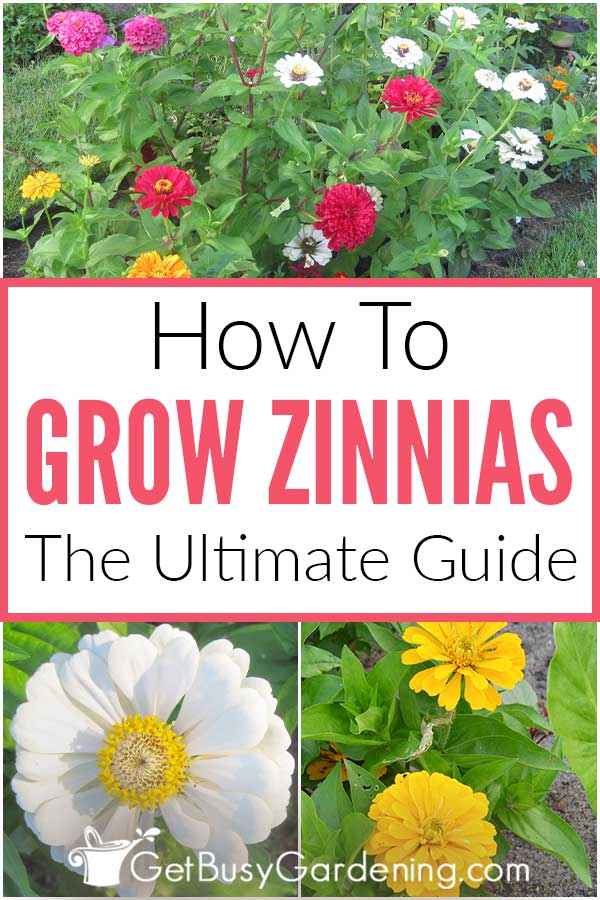
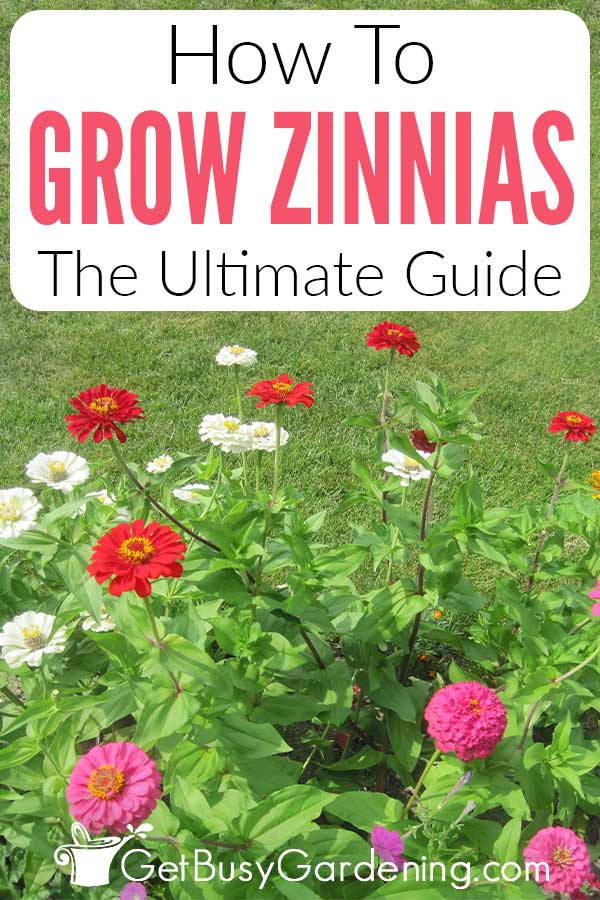
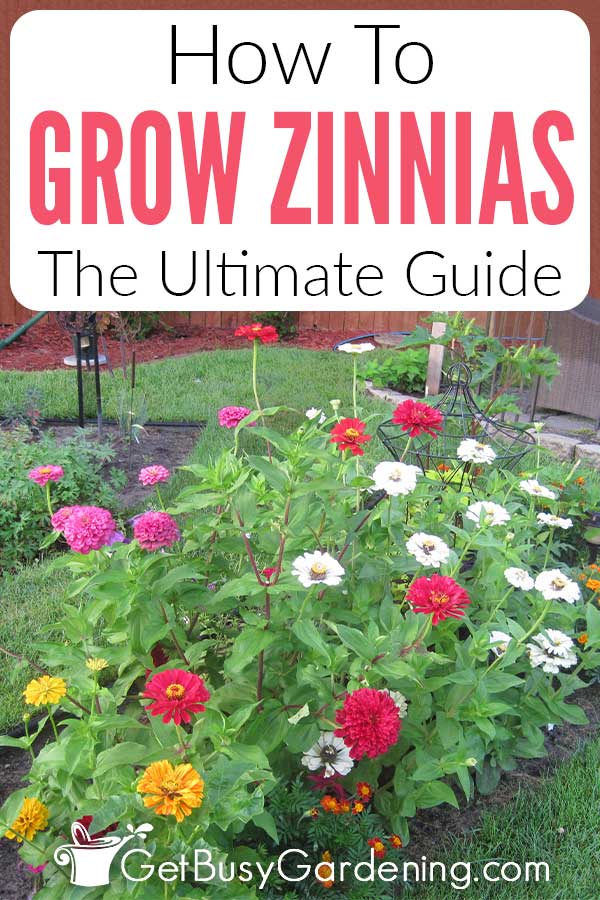
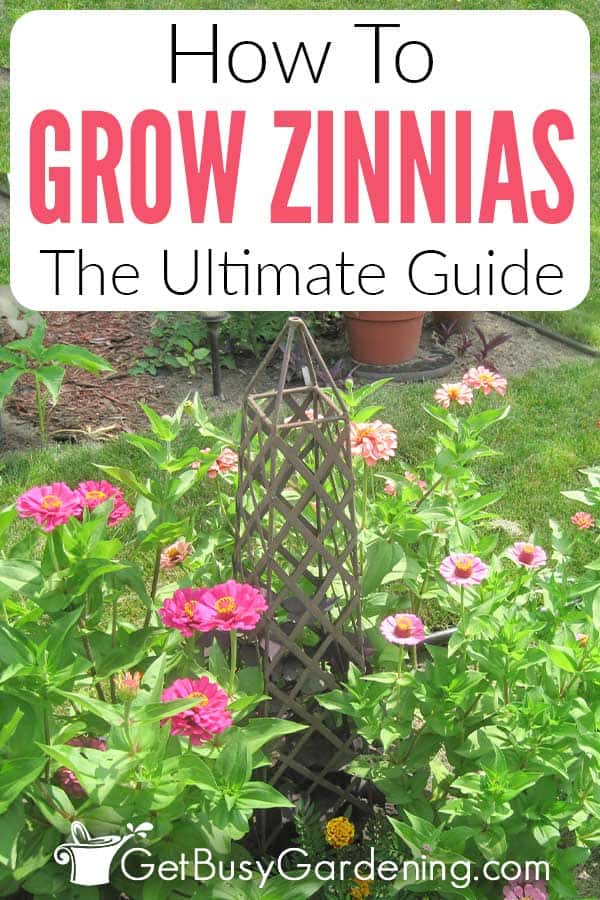
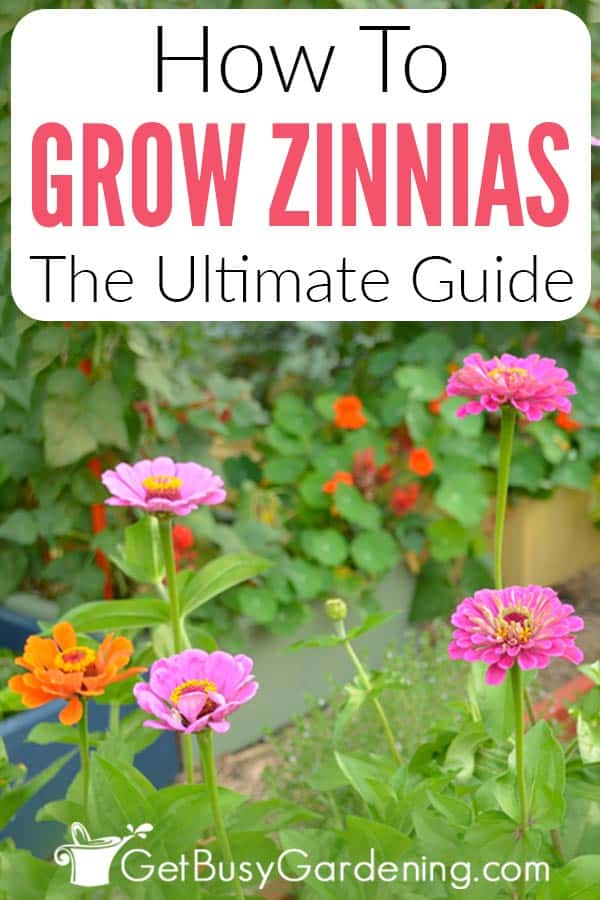


Sherry says
I thought this might gave been a book on zinnias. Are there any out there ?
Amy Andrychowicz says
I wasn’t sure, so I did a quick search on Amazon and found this one… A History of Zinnias: Flower for the Ages . I’ve never read it, so I can’t give you any recommendation on how good it is, but it has good ratings. Now we know there’s at least one book out there. 🙂
Christine says
I’ve never grown my own flowers in a planter, however I am quite proud of the progress i’ve watched with these gorgeous zinnias! I am so excited to see them all in full bloom!! What a strong yet beautiful flower!!
Amy Andrychowicz says
Yes, zinnias are wonderful and so easy to grow!
Linda muir says
Do the deer eat zinnias?
Amy Andrychowicz says
Zinnias are not appealing to deer, and they usually do not eat it. However, all bets are off if the deer is hungry enough, LOL!
JessB says
My veg garden isn’t complete without zinnias! I agree with all your points and would add HAPPINESS to your list of benefits. They just make me happy every time I see them. I save my own seed from them but just ordered 5 other varieties to get more color into the mix!
Amy Andrychowicz says
Yes, zinnias do make a wonderful companion plant to veggies! They add tons of color, and attract all those beneficial pollinators that will help your garden produce even more. Happiness is a great addition to the list of zinnia benefits, I love it! They make me happy too. 🙂
Joe says
I’ve never grown zinnias before, but I think I’ll definitely start. They’re beautiful!
Amy Andrychowicz says
Yes, you definitely should try growing zinnias. They are easy, and so rewarding! Have fun! 🙂